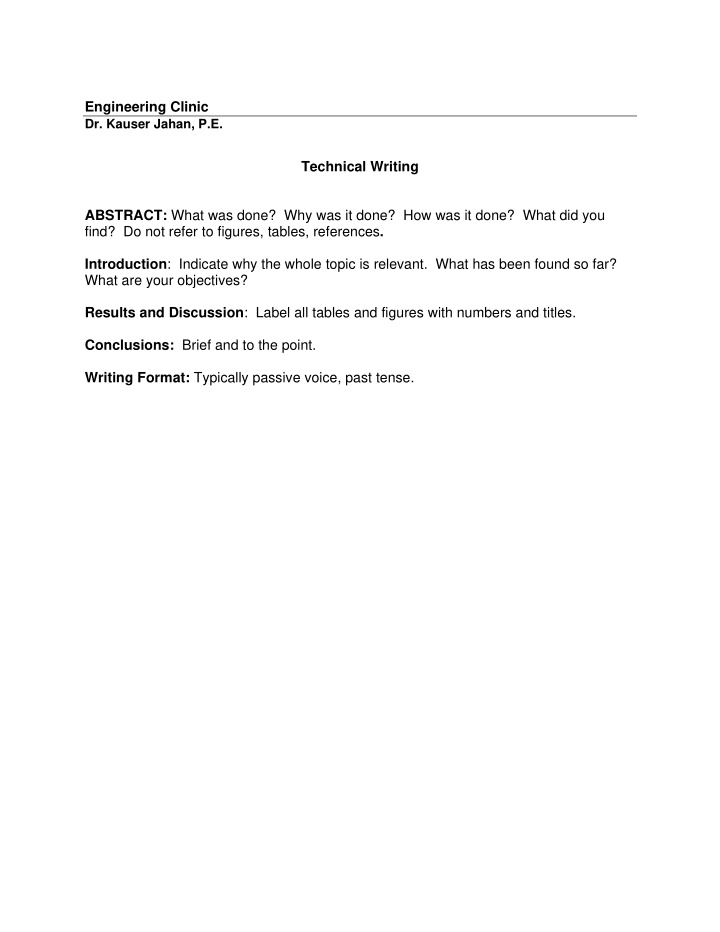



Engineering Clinic Dr. Kauser Jahan, P.E. Technical Writing ABSTRACT: What was done? Why was it done? How was it done? What did you find? Do not refer to figures, tables, references . Introduction : Indicate why the whole topic is relevant. What has been found so far? What are your objectives? Results and Discussion : Label all tables and figures with numbers and titles. Conclusions: Brief and to the point. Writing Format: Typically passive voice, past tense.
Sample Abstracts: Removal of Ammonia by Chlorella vulgaris The capability of Chlorella vulgaris to remove nitrogen in the form of ammonia and/or ammonium ions from wastewater effluent in a local wastewater treatment plant (i.e., the Mill Creek Plant in Cincinnati, Ohio, U.S.A.) was studied. The wastewater effluent leaving the plant was found to include high concentrations of nitrogen (7.7±0.19 mg/L) (ammonia (NH 3 ) and/or + )) and total inorganic carbon (58.6±0.28 mg/L) at pH 7, and to be suitable ammonium ion (NH 4 for growing Chlorella vulgaris . When Chlorella vulgaris was cultivated in a batch mode under a closed system, half of the nitrogen concentration was dramatically removed in 48 h after a 24-h lag-phase period. Total inorganic carbon concentration also concomitantly decreased during the rapid growth-phase. The total biomass weight gained during the entire cultivation period balanced out well with the total amount of inorganic carbon and nitrogen removed from the culture medium. These results indicate that wastewater can be synergistically used to polish residual nutrients in wastewater as well as to cultivate microalgae for biofuel production. Technovation Volume 13, Issue 2, March 1993, Pages 63-71 University scientists as entrepreneurs: a special case of technology transfer and high-tech venturing We trace the commercialization of new technologies when enacted specifically under the stewardship of the founding university scientist. Our primary evidence comes from an intensive study of 22 such enterprises in North America. The implications for all parties involved, including the business partners and university employers, are addressed. The clash of business and scientific cultures often leads to difficulties in the partners working together and sometimes to outright failure of the venture. Likewise, tension in the scientist's relationship with the university produces unfortunate losses for both sides. The lack of a common venture culture, as well as difficulties in the relationship with the university, might be labelled as ‘obvious’ by students of organizing and organizations. Equally, many venturing scientists recognize their lack of management skills as a potential barrier to success. Yet, it is striking how little preventive action is taken to avoid or remedy such problems. They appear to be consistently overlooked. For instance, creative resolutions of the academic's new status occurred only in a minority of our cases: the majority of the scientists severed their ties with their universities. The patterns exposed in this study offer helpful insights to budding scientist- entrepreneurs contemplating a foray into the commercial marketplace, to business partners interested in enhancing the probability of making the right career move, and to universities seeking a stake in the success of these ventures.
References: Alphabetical order (Author’s Last Name, Followed by initials) Website : url with Access Date See samples below: Microbial arsenate metabolism was first identified by Green (1918). Green isolated an arsenate reducer, Bacterium arenreducens , and an arsenite oxidiser B. arsenoxydans . Since then numerous researchers have reported on isolating arsenate-reducing bacteria from arsenic rich soils and sediments using anaerobic media where As(V) serves as the sole terminal acceptor (Nicholas et al, 2003). Bacteria have been shown to reduce oxyanions of arsenic. Stolz and Oremland (1999) provided the reduction reactions that select bacteria perform on these oxyanions of arsenic. Green, H.H.: 1918, “Description of a bacterium which oxidizes arsenite to arsenate and of one which reduces arsenate to arsenite, isolated from a cattle-dipping tank.” S. Afr. J. Sci . 14 , 465- 467. Nicholas, D.R., Ramamoorthy, S., Palace, V., Spring, S., Moore, J. N. and Rozenzweig, R. F.: 2003, “Biogeochemical Transformations of Arsenic in Circumneutral Freshwater Sediment” Biodeg . 14 , 123-137. Stolz, J.F. and Oremland, R.S.: 1999,”Bacteria Respiration of Arsenic and Selenium” FEMS Micr. Rev ., 23 , 615-627. Green [1] first identified microbial arsenate metabolism. He isolated an arsenate reducer, Bacterium arenreducens , and an arsenite oxidiser B. arsenoxydans . Since then numerous researchers have reported on isolating arsenate-reducing bacteria from arsenic rich soils and sediments using anaerobic media where As(V) serves as the sole terminal acceptor [2,3]. Bacteria have been shown to reduce oxyanions of arsenic. Reduction reactions that select bacteria perform on these oxyanions of arsenic have been reported [3, 4]. [1] Green, H.H.: 1918, “Description of a bacterium which oxidizes arsenite to arsenate and of one which reduces arsenate to arsenite, isolated from a cattle-dipping tank.” S. Afr. J. Sci . 14 , 465-467. [2] Nicholas, D.R., Ramamoorthy, S., Palace, V., Spring, S., Moore, J. N. and Rozenzweig, R. F.: 2003, “Biogeochemical Transformations of Arsenic in Circumneutral Freshwater Sediment” Biodeg . 14 , 123-137. [3] Stolz, J.F. and Oremland, R.S.: 1999,”Bacteria Respiration of Arsenic and Selenium” FEMS Micr. Rev ., 23 , 615-627. [4] http://www.ehow.co.uk/about_6656988_red-marine-algae-vs_-kelp.html Accessed Feb 8, 2011.
Common Errors: Reference: http://www.sciencedirect.com/science?_ob=MImg&_imagekey=B6VS4-4BMK3RR-1- 5&_cdi=6252&_user=687457&_pii=S1369526604000159&_origin=search&_zone=rslt_li st_item&_coverDate=04/30/2004&_sk=999929997&wchp=dGLbVlz- zSkWb&md5=a07c30aeb11d148e5b8edc6b02139717&ie=/sdarticle.pdf Correct reference: Franklin, S. E and S. P. Mayfield (2004) Prospects for molecular farming in the green alga Chlamydomonas reinhardtii . Current Opinion in Plant Biology , 7(2), Pages 159-165. Poor Graph
Recommend
More recommend